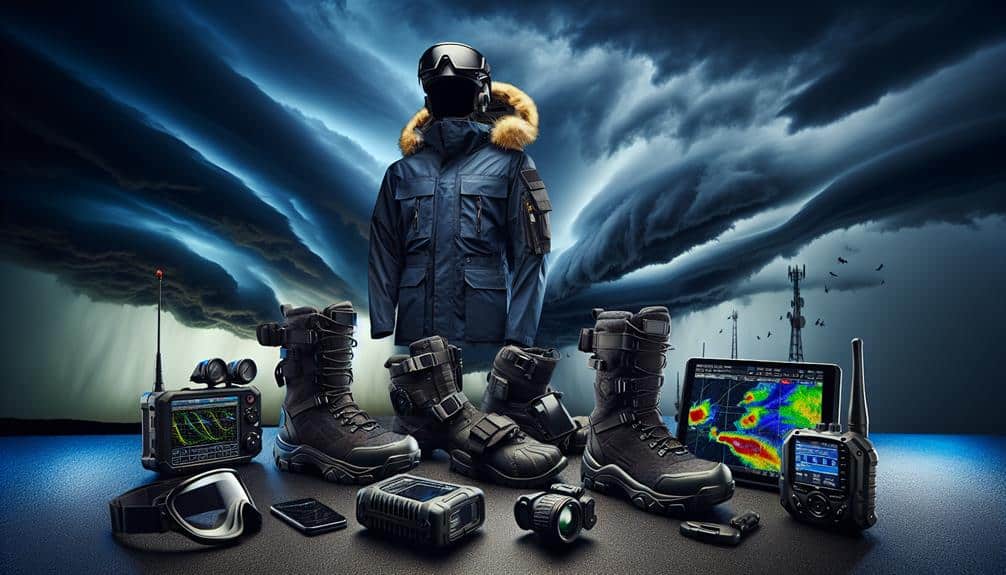As storm chasers, identifying stress signals like headaches, fatigue, and anxiety is vital for our mental health. We can handle stress through mindfulness, deep breathing, and staying physically active. Building a strong support network, including peer groups and therapy sessions, offers crucial emotional support. On the field, using relaxation techniques and guaranteeing proper rest, hydration, and nutrition helps us manage anxiety. Embracing these practices not only enhances our mental resilience but also ensures our passion remains fulfilling rather than overwhelming. For more thorough strategies and expert advice, let's explore further.
Key Points
- Recognize stress signals like fatigue, anxiety, and difficulty concentrating to prevent burnout and maintain effectiveness.
- Use mindfulness and deep breathing techniques to reduce stress and enhance decision-making.
- Build a robust support network through peer support, group therapy, and community outreach.
- Prioritize self-care with regular sleep, physical activity, and balanced nutrition.
Recognizing Stress Signals
Recognizing stress signals is vital for storm chasers, as the high-pressure environment can take a toll on both mental and physical health. We've all been there—facing the adrenaline rush of an impending storm, the urgency of capturing data, and the endless variables we can't control. It's important to identify when these pressures start affecting us negatively.
For effective stress management, we need to be aware of common stress signals. Physically, this can include headaches, fatigue, or muscle tension. Mentally, we might experience irritability, anxiety, or difficulty concentrating. Ignoring these signs can lead to burnout, which ultimately diminishes our effectiveness and enjoyment of storm chasing.
Let's remember that our mental health is as important as our equipment. Evidence shows that prolonged stress can impair cognitive functions and decision-making abilities, which are critical in our line of work. Identifying stress signals early allows us to address them before they escalate.
Developing Coping Mechanisms
As storm chasers, we need effective coping mechanisms to manage the unique stressors we face.
Practicing mindfulness and breathing techniques, building strong support networks, and actively managing our stress levels can greatly improve our mental health.
Let's explore how these strategies can help us stay resilient and focused in the field.
Mindfulness and Breathing Techniques
Storm chasers can greatly benefit from mindfulness and breathing techniques to manage the intense stress and anxiety inherent in their high-risk profession. By focusing on the present moment, we can significantly reduce stress levels and improve our ability to make clear, quick decisions. Evidence shows that mindfulness practices, such as meditation and mindful breathing, offer substantial stress relief, helping us stay grounded amidst chaos.
Relaxation techniques like deep breathing exercises are particularly effective. By taking slow, deliberate breaths, we activate the body's parasympathetic nervous system, which counteracts the adrenaline rush that often accompanies storm chasing. This physiological response not only calms our minds but also sharpens our focus, enabling us to navigate high-pressure situations more effectively.
Let's also consider progressive muscle relaxation, a method where we systematically tense and then relax different muscle groups. This practice helps release physical tension and promotes a sense of tranquility. Incorporating these techniques into our routine can transform how we handle the mental demands of storm chasing.
Building Support Networks
Creating a robust support network is essential for us to develop effective coping mechanisms and maintain our mental well-being in the demanding field of storm chasing. Storm chasing is exhilarating, yet it comes with unique stressors that can affect our mental health. Connecting with others who share our experiences can provide invaluable support.
We can start by participating in group therapy sessions, where we share our thoughts and feelings in a structured setting. These sessions can help us process our experiences and learn from others. If in-person meetings aren't feasible, online forums offer a flexible alternative. They allow us to engage with a broader community, sharing advice and support in real-time.
Peer support is another cornerstone of our mental health strategy. Forming bonds with fellow storm chasers who understand the highs and lows of our work can provide a sense of camaraderie and emotional safety. Additionally, community outreach initiatives can expand our support network beyond our immediate circle. By engaging with local communities, we not only raise awareness about storm safety but also build relationships that can serve as emotional anchors.
In essence, cultivating a diverse support network empowers us to navigate the emotional complexities of storm chasing more effectively.
Managing Stress Levels
Managing our stress levels is important, and developing effective coping mechanisms can make all the difference in maintaining our mental health while storm chasing. We've all felt the adrenaline surges and the intense focus required during these pursuits, but without proper stress management, our passion can quickly become overwhelming.
Embracing self-care is crucial; it's not a luxury but a necessity.
One of the most effective coping strategies is to establish a solid routine that includes relaxation techniques. Deep breathing exercises, for example, can help calm our nervous system in high-pressure situations. Practicing mindfulness can also keep us grounded, allowing us to stay present and make clear-headed decisions amid the chaos.
Incorporating physical activity into our daily regimen can serve as an excellent stress reliever. Activities such as yoga, running, or even a brisk walk can greatly lower stress levels. Let's not underestimate the power of rest either—ensuring we get adequate sleep is important for mental resilience.
Lastly, connecting with fellow storm chasers through support networks or peer groups can provide emotional support and practical advice, reinforcing our coping strategies.
Building a Support Network

Establishing a strong support network is crucial for storm chasers to maintain both their mental and emotional well-being amidst the high-stress nature of their work. Peer support and group therapy are invaluable tools in our mental health toolkit. By connecting with others who share similar experiences, we can exchange strategies for coping and build a sense of camaraderie that eases the emotional burden.
Participating in group therapy sessions can offer us a structured environment to discuss our challenges and learn from others. These sessions provide a safe space for expressing emotions and gaining insights into effective coping mechanisms. Knowing we're not alone in our struggles can greatly boost our resilience.
Beyond formal therapy, fostering a community among fellow storm chasers can be immensely beneficial. Regular check-ins, either online or in person, help us stay connected and offer support when needed. Sharing our experiences, both the highs and lows, creates a sense of belonging and mutual understanding.
At the end of the day, having a robust support network ensures we're not facing these intense situations alone. It empowers us to continue pursuing our passion while safeguarding our mental health. Let's prioritize building these essential connections.
Managing Anxiety on the Field
Facing the unpredictable nature of storms head-on can trigger significant anxiety, but with the right strategies, we can manage these intense emotions effectively. Anxiety triggers are common in storm chasing due to the inherent uncertainties and potential dangers. Recognizing these triggers is the first step in managing our anxiety.
Field safety is paramount. Knowing we've taken all necessary precautions to guarantee our physical safety can greatly reduce anxiety. Regularly reviewing and practicing our safety protocols can instill confidence and calm. Equipping ourselves with the latest weather updates and maintaining clear communication with our team also contributes to a sense of control.
In addition to safety measures, incorporating relaxation techniques into our routine can help manage stress. Simple practices like deep breathing exercises or mindfulness can be remarkably effective. Taking a few moments to focus on our breath can ground us, helping to keep anxiety at bay.
Self-care is essential, even in the field. Ensuring we're well-rested, hydrated, and nourished can make a significant difference in our mental resilience. By balancing field safety with relaxation techniques and self-care, we can navigate the thrilling, yet challenging, world of storm chasing with a calmer, more focused mindset.
Prioritizing Self-Care

As storm chasers, we need to prioritize self-care to maintain our mental health and effectiveness in the field. Managing stress levels, establishing a consistent rest routine, and practicing mindfulness techniques can greatly enhance our well-being.
Let's explore these strategies to guarantee we're at our best, both mentally and physically.
Manage Stress Levels
To manage stress levels effectively, we need to prioritize self-care practices that cater to both our mental and physical well-being. As storm chasers, we often face high-stress environments that can take a toll on our mental health. Adopting evidence-based stress reduction techniques is pivotal for maintaining balance and resilience.
Here are three essential self-care practices we can implement:
- Mindfulness and Meditation: Engaging in mindfulness exercises or meditation can significantly reduce stress. By focusing on the present moment, we can lower our anxiety levels and improve our mental clarity, which is crucial in high-pressure situations.
- Physical Activity: Regular exercise is a powerful tool for stress reduction. Activities like jogging, yoga, or even a brisk walk can release endorphins, our body's natural stress relievers. Incorporating physical activity into our routine can help us stay physically fit and mentally sharp.
- Social Support: Connecting with fellow storm chasers or loved ones provides emotional support and a sense of community. Sharing experiences and discussing challenges can alleviate stress and foster a supportive network, vital for our well-being.
Establish Rest Routine
Prioritizing a consistent rest routine is essential for storm chasers to recover physically and mentally from the demands of their work. Given the unpredictable nature of our profession, we must make deliberate efforts to maintain good sleep hygiene. This means setting regular sleep and wake times, even when we're on the road.
Our bodies thrive on routine, and a consistent schedule can help us feel more rested and alert.
In addition to establishing a regular sleep pattern, incorporating relaxation techniques into our daily routine can greatly enhance our well-being. Simple practices like deep breathing exercises, progressive muscle relaxation, or even a short meditation session can prepare our minds for restful sleep. Research shows that these techniques can lower stress levels and improve sleep quality, making it easier for us to recharge.
Let's remember that self-care isn't a luxury—it's a necessity. By prioritizing rest and relaxation, we can maintain the mental clarity and physical stamina needed to navigate the challenges of storm chasing. In the end, taking these steps not only benefits our health but also enhances our ability to pursue our passion with the freedom and energy it deserves.
Practice Mindfulness Techniques
Incorporating mindfulness techniques into our daily routine can greatly enhance our mental resilience and overall well-being as storm chasers. The high-stress environment we navigate demands that we prioritize self-care to maintain peak performance and mental health.
Here are three mindfulness techniques that can make a significant difference:
- Meditation Practice: Engaging in a daily meditation practice can help us manage stress, improve focus, and enhance emotional stability. Even just a few minutes a day can create a buffer against the mental strain we face.
- Grounding Exercises: Grounding exercises, such as 5-4-3-2-1 (naming five things we see, four things we touch, three things we hear, two things we smell, and one thing we taste), can bring us back to the present moment. These exercises are particularly useful during high-adrenaline chases, helping us stay centered and calm.
- Breath Control: Simple breath control techniques, like deep diaphragmatic breathing, can lower our heart rate and reduce anxiety. Practicing controlled breathing before and after a chase can help us shift smoothly between high-energy and rest states.
Seeking Professional Help
Recognizing when it's time to seek professional help can be an important step in maintaining our mental health as storm chasers. Our profession is thrilling, but it also subjects us to high stress and unpredictable conditions.
Engaging in therapy sessions can provide us with essential coping strategies tailored to our unique challenges. These strategies can be vital in maintaining our mental resilience, allowing us to continue doing what we love without compromising our well-being.
Professional support isn't a sign of weakness; it's a proactive step toward sustaining our mental health. Mental health professionals understand the specific pressures we face and can offer targeted interventions.
Studies show that individuals who seek therapy experience significant improvements in managing stress and anxiety. This means we can better weather the emotional storms that come with our occupation.
Moreover, having a dedicated space to discuss our experiences can be liberating. We don't have to carry the weight of our fears and anxieties alone. By seeking professional help, we gain tools to navigate both the literal and metaphorical storms in our lives.
Let's remember that reaching out for support is a courageous act that empowers us to chase our dreams more sustainably.
Frequently Asked Questions
How Can Storm Chasing Impact Long-Term Mental Health?
Storm chasing can have long-term effects on mental health. We must develop coping strategies and prioritize self-care to manage the emotional toll. Balancing the excitement with mental well-being is essential for sustaining our passion safely.
What Are Common Misconceptions About Mental Health in Storm Chasing?
Did you know that 40% of storm chasers report mental health struggles? There's a stigma around seeking help, but increasing awareness and using effective coping mechanisms and self-care can greatly improve our well-being and resilience.
Are There Specific Mental Health Risks Unique to Storm Chasers?
Yes, storm chasers face unique psychological effects, including extreme stress and trauma. We need strong coping strategies and support systems. Effective coping mechanisms, like mindfulness and peer support, help us manage these intense mental health risks.
How Can One Balance Storm Chasing With Personal Life and Mental Well-Being?
To balance storm chasing with personal life and mental well-being, we should prioritize work-life balance and self-care. Effective coping strategies and mindfulness practices can help us maintain stability, ensuring our passion doesn't overwhelm our freedom and happiness.
What Role Does Adrenaline Play in the Mental Health of Storm Chasers?
Adrenaline feels like a rocket launch! We need adrenaline management and coping strategies to maintain mental health. Building resilience helps us handle the highs and lows, ensuring we stay balanced while chasing the ultimate freedom.


